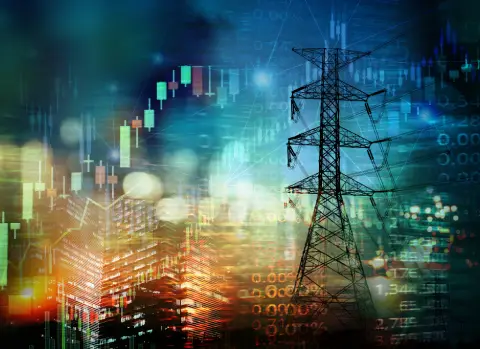Energy procurement presents a unique challenge for organizations, requiring indirect procurement managers to adeptly navigate regulatory compliance, growing demands for sustainable energy, and fluctuating rates. Developing a strategic energy procurement plan and issuing an energy RFP can yield significant cost savings while mitigating risks and enhancing reliability. Our SpendEdge latest blog guides you through the process of issuing an energy RFP, highlight the benefits of effective energy procurement, and offers insights to help you navigate the energy market with confidence.
Key Concepts and Considerations
Energy procurement, often referred to as utility procurement, is the process of sourcing essential energy resources, including electricity, natural gas, renewable energy, and other related sources required by an organization. This procurement process involves issuing a Request for Proposal (RFP) to energy suppliers, evaluating their submissions, negotiating contractual agreements, and managing the ongoing relationships with energy suppliers.
Organizations Benefiting from Energy Procurement
Deregulated Markets:
Organizations operating in deregulated states should conduct energy RFPs periodically to secure the most competitive rates available.
Industrial Organizations:
Industrial entities benefit from energy procurement due to their high energy consumption and need for reliable supply.
Medium to Large Enterprises:
Businesses of medium to enterprise size often engage in energy procurement strategies to manage costs and ensure efficiency.
Nonprofit Organizations:
Nonprofits can leverage energy procurement to optimize their budgets and enhance sustainability efforts.
Government Entities:
Public sector organizations utilize energy procurement to ensure compliance with regulations while managing taxpayer resources.
Energy Cooperatives:
Organizations that form energy cooperatives leverage collective purchasing power to negotiate better rates for energy procurement.
Key Components
- Understanding Energy Needs: Assess historical energy consumption and predict future demands by analyzing usage patterns, peak times, and operational requirements to ensure efficient energy management.
- Supplier Evaluation: Analyze potential energy suppliers for reliability, financial stability, and sustainability practices. Review performance histories and customer feedback to select the best partners.
- Contract Negotiation: Negotiate favorable contract terms with selected suppliers, focusing on pricing structures, contract duration, and performance guarantees to align with operational goals and budget constraints.
- Cost Control: Implement strategies to maintain competitive pricing and budget stability. Monitor market trends and explore bulk purchasing or long-term contracts for cost savings.
- Risk Management: Develop strategies to mitigate risks from price volatility and supply disruptions. Diversify energy sources and establish contingency plans to ensure reliable energy supply.
- Renewable Integration: Incorporate renewable energy sources into the procurement strategy to enhance sustainability. Invest in solar, wind, or other green initiatives to lower costs and reduce environmental impact.
Key Steps Involved in Energy Procurement Strategies
| Step | Description | Key Actions |
|---|---|---|
| 1. Market Assessment | Evaluate the organization’s energy needs and consumption patterns. | – Analyze historical energy usage. – Identify specific energy requirements based on operations. |
| 2. Supplier Evaluation | Research and assess potential energy suppliers based on reliability, cost, and sustainability. | – Compare supplier offerings. – Review supplier performance history and sustainability practices. |
| 3. Contract Negotiation | Negotiate terms with selected suppliers to finalize contracts that align with business goals. | – Discuss pricing structures and contract duration. – Ensure terms meet operational and budget needs. |
| 4. Implementation | Execute the procurement plan by coordinating with suppliers for a smooth transition to new energy sources. | – Align internal processes with new agreements. – Ensure all stakeholders are informed of changes. |
| 5. Energy Consumption Monitoring | Continuously monitor energy usage to ensure compliance with contracts and identify areas for improvement. | – Utilize smart meters and IoT devices for real-time data. – Adjust consumption strategies as needed. |
| 6. Performance Review | Regularly evaluate supplier performance and contract effectiveness to adapt to changing needs. | – Conduct periodic assessments of supplier reliability and cost-effectiveness. – Adjust procurement strategies based on market conditions. |
| 7. Risk Management | Identify and mitigate risks associated with energy supply fluctuations and regulatory changes. | – Develop contingency plans for supply disruptions. – Stay informed about regulatory updates impacting energy procurement. |
Strategic Benefits of Clean Energy Procurement
Ensure Competitive Pricing:
Adapt to rate fluctuations and secure the best pricing options.
Consolidate Energy Costs:
Streamline energy expenses across multiple locations or facilities.
Negotiate Favorable Contract Terms:
Secure contracts with terms that align with your organization's needs.
Improve Cost Visibility:
Gain clearer insights into operating costs for better financial planning.
Access Sustainable Energy Options:
Explore affordable, environmentally friendly energy alternatives.
Enhance Forecasting:
Utilize data-driven insights to better predict energy usage and market trends.
Exploring Energy Procurement Contracts: Key Structures and Insights
Energy procurement contracts come in various forms, each tailored to address distinct business needs. Choosing the right contract is a nuanced process influenced by external factors like site-specific energy demands and market trends, all of which determine the rates reflected on your energy bill. Often, adopting a blended procurement approach—combining fixed and indexed pricing elements—delivers the best of both worlds. The success of your energy strategy ultimately depends on timing, market dynamics, contract type, and the metrics you use to measure performance, such as cost per unit, total expenditure, or budget alignment. Below are the primary energy contract types explained:
Fixed Energy Contracts
Fixed pricing contracts provide stability by locking in a set electricity rate for the entire contract duration. This approach safeguards businesses from market volatility, offering predictable costs regardless of external price fluctuations caused by factors such as weather or regulatory changes. Fixed contracts are especially beneficial when market prices are expected to rise steadily. However, the downside is the inability to capitalize on potential price drops during the contract term, as the fixed rate remains constant. The main risk lies in committing to a rate during market highs, which can result in paying more than the current market prices if rates decline.
Indexed Electricity Pricing Contracts
Indexed pricing plans take the opposite approach, with rates directly tied to real-time market prices. This model often delivers long-term savings, as it adjusts with market conditions. However, it comes with significant exposure to price volatility, which can lead to unexpected cost spikes. This contract type is ideal for businesses willing to accept market fluctuations for the chance of reduced costs but requires careful planning to handle unpredictable price variations effectively.
Block and Index Pricing Strategy
The block and index strategy offers a hybrid solution by blending fixed and indexed pricing elements. It allows businesses to lock in fixed-price “blocks” during periods of anticipated high volatility, such as peak demand seasons. These blocks can be tailored to specific timeframes or load requirements, giving businesses control over the extent of their risk mitigation. The flexibility of layering hedges over time enables businesses to reduce exposure to unfavorable market conditions gradually. Additionally, some providers offer hedging options based on load percentages, simplifying the strategy and making it adaptable to various operational needs.
How SpendEdge Can Help You
At SpendEdge, we specialize in guiding organizations through the complexities of energy procurement. Our expertise in market intelligence, strategic sourcing, and data analytics empowers businesses to make informed, cost-effective decisions. Whether you’re navigating deregulated markets, managing energy costs across multiple locations, or exploring sustainable energy options, SpendEdge provides tailored solutions that help you:
- Develop a robust energy procurement strategy that aligns with your organization’s goals.
- Secure competitive pricing by leveraging our extensive network of trusted suppliers.
- Simplify the RFP process with expert support in drafting, evaluating, and negotiating contracts.
- Ensure compliance with evolving energy regulations and sustainability standards.
- Gain actionable insights into energy usage and market trends to improve forecasting and budgeting.
Mastering energy procurement requires a strategic approach that balances cost efficiency, risk management, and sustainability. By leveraging advanced analytics, evaluating market trends, and integrating renewable energy solutions, organizations can optimize energy strategies and ensure long-term savings. A well-structured energy RFP process is critical for securing competitive contracts, mitigating risks, and driving operational reliability. Unlock the potential of smart energy procurement to navigate market complexities and achieve your organization’s sustainability and financial goals.
Let SpendEdge be your partner in mastering energy procurement and unlocking long-term savings. To learn more about how we can help you optimize your energy strategy today…





